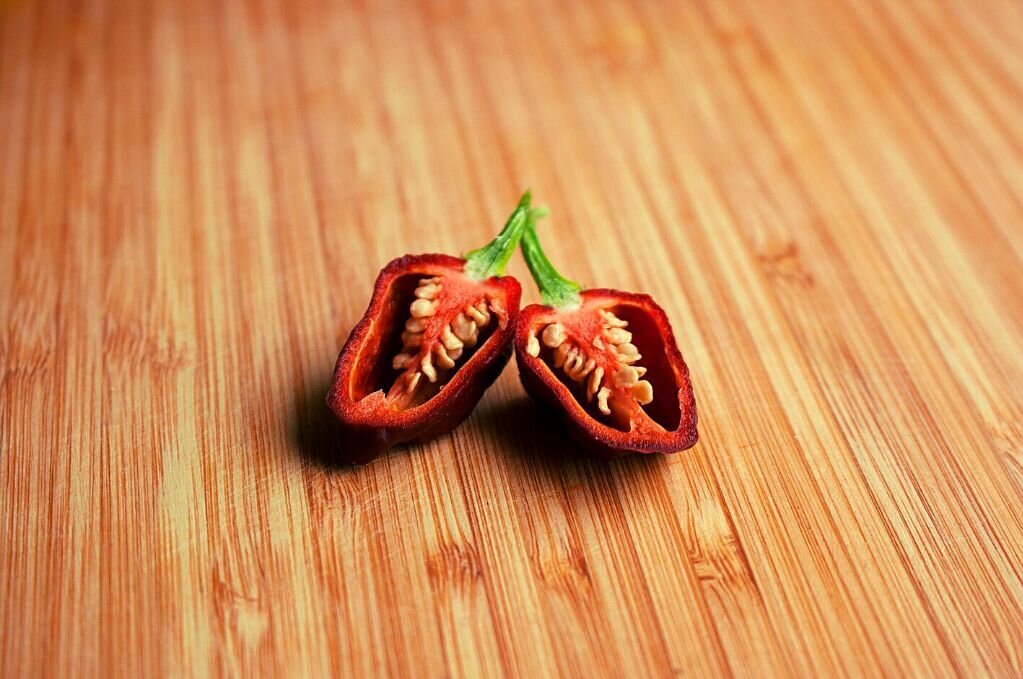The apocalypse scorpion pepper is an incredibly spicy chili pepper originating from Italy. The fruit is deep red with a rough, almost melted-looking exterior and a long, pointed tail resembling that of a scorpion’s stinger. The intense heat level (up to 1.4M SHUs) and sweet flavors of these peppers make them stand out as a favorite among chili fanatics.
What Is The Apocalypse Scorpion Pepper?
Apocalypse scorpion peppers were first developed and bred by AIASP, an Italian pepper group dedicated to creating and enjoying spicy peppers. These chilis are the hottest Italy offers, though Italy is famous for other delicious chilis, such as Calabrian peppers and pepperoncini.
From just one look at these peppers, you’ll know they’re no joke! The fruit is deep red with a rough, almost melted-looking exterior and a long, pointed tail resembling that of a scorpion’s stinger. These warped and fiery red peppers have earned their intimidating name and a spot amongst the world’s hottest peppers.
How Spicy Is An Apocalypse Scorpion Pepper?
Apocalypse scorpion peppers are as spicy as their name might suggest: unbelievably hot! Initial Scoville heat unit testing of this variety of Capsicum chinense indicates that they are around 1,200,000-1,450,000 SHUs. This puts them near the top of the Scoville scale, comparable with the Carolina reaper, which averages between 1,400,000-2,200,000 SHUs.
Comparing this to a jalapeno pepper, which is 2,500-8,000 SHUs, apocalypse scorpions are about 200 to 500 times spicier. You want to approach this pepper carefully, as consuming super-hot peppers can cause severe pain and discomfort.
Try something in the range of a scotch bonnet pepper, between 100,000-350,000 SHUs, before leaping to the apocalypse scorpion. You’ll understand your level of pain tolerance much better as you work your way up the Scoville scale, and trying peppers in the six-digit level will prepare you for what’s to come at the top.
What Does It Mean When A Pepper Plant Is “Unstable?”
As with many new hybrid peppers, apocalypse scorpions are considered unstable. This means that they’re still in the breeding process, and enough generations have not been produced to create consistent heat, taste, and appearance. Factors such as growing conditions and being open-pollinated will affect hybridized plants’ stability.
What this means for the pepper plant’s fruit is that the spiciness level fluctuates drastically. While there have been reports of the apocalypse scorpion reaching 1,400,000 SHUs, there have also been peppers from similar plants that are far milder. This is why the apocalypse scorpion has yet to be officially recognized by Guinness as one of the hottest peppers in the world since they need to consistently lab test at a certain SHU.
Can You Eat Apocalypse Scorpion Peppers?
Despite being incredibly spicy, apocalypse scorpion peppers are safe to consume. Like many other Capsicum chinense peppers, like scotch bonnets, ghost peppers, habaneros, and the infamous Carolina reaper pepper, apocalypse scorpions have a fruity and sweet flavor profile. While their extreme heat might seem overwhelming, the flavors are surprisingly complex and enjoyable.
If you plan on cooking with apocalypse scorpions, it’s important to proceed with caution. Handling seriously spicy chilis without gloves or protective eyewear can cause extreme pain.
Also, you’ll likely only want to use tiny amounts of these peppers when cooking, as a little will go a long way in adding heat to a dish. Apocalypse scorpions are fantastic for adding a lot of spicy character to marinades, stews, and especially hot sauces. Remove much of the pepper’s membrane and seeds before cooking with apocalypse scorpions, as that is where most of the intense spiciness comes from in the pepper.
Substitutes For These Super Hot Peppers
If you can’t get your hands on apocalypse scorpions or you’re just looking for the next hottest thing, then there are a few other scorching peppers that I’d recommend trying out!
Of course, you should try the infamous Carolina reaper, which still holds the world record for being the world’s hottest chili pepper. At 1,400,000-2,200,000 SHUs, it’s in a similar heat range as the apocalypse scorpion, with a similar flavor profile.
The Trinidad Moruga scorpion pepper is thought to be a relative of the apocalypse scorpion and brings even more heat to the party! Trinidad Moruga scorpions vary in heat between 1,550,000-2,000,000 SHU and offer similar fruity and sweet flavors that are also present in apocalypse scorpions.
Can You Grow Apocalypse Scorpion Peppers?
If you’re interested in acquiring apocalypse scorpions of your own, growing them in the backyard is the best way to do it! Apocalypse scorpion pepper seeds are readily available online from a wide variety of retailers, such as Baker Creek, and grow similarly to other hot pepper plants.
I recommend starting these plants indoors 2-3 months before the last frost of the season to ensure your seeds have enough time for successful germination. Once you transplant the seedlings outside, the plants will need to receive full sun all day and will thrive best in climates that offer temperatures between 75°F-100°F.
Fully mature plants will reach about 4 feet tall and yield dozens of peppers during the growing season. Once you start seeing peppers begin to form, you’ll want to start regularly fertilizing your plants to ensure optimal fruit growth.
Apocalypse scorpion peppers can be overwintered if brought in before winter. It’s recommended that you place them in full sun or under a growing lamp while overwintering, and you should keep them out of reach of children or pets.

